The Irvines – from whence they came.
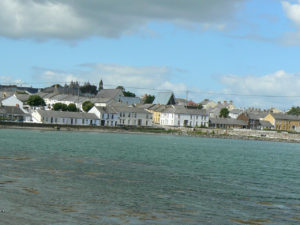
Killyleagh village on Strongford Lough, Co. Down. Photo by R.Edes
My Irvine ancestors set out from Killyleagh, a beautiful village in County Down, situated on the shores of Strangford Lough. This story aims to tell you a little about the history of the area and the senior members of the family.
Although the village was settled in the 12th century, it was in 1602 that the Scots-Irish influence began. At this time the Gaelic chieftain Con O’Neill of Clandeboye owned much of North Down, including Killyleagh. O’Neill had sent his men to attack the English soldiers but ended up being imprisoned by them. His wife made a deal with Scots aristocrat Hugh Montgomery to give him half of their land if he could secure a royal pardon for her husband. This Montgomery did but James 1 divided the land into three with Killyleagh and the region north allocated to another Scottish land owner, James Hamilton, who later became the 1st Viscount Clandeboye.[1] Dunlop is just to the north of the town of Irvine on the Ayrshire coast and this is where Hamilton grew up. He was Bursar at Trinity College in Dublin from 1598, and it is noted that during his tenure he established a school in Killyleagh.
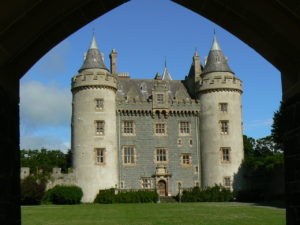
Killyleagh Castle – home of the Hamilton family for over 400 years. Photo R.Edes
This was before the Plantation of Ulster, and the two Ayrshire Scots – James Hamilton and Hugh Montgomery pioneered a massive migration from the Lowlands of Scotland to County Antrim and County Down. Beginning in May 1606, over ten thousand, mainly Presbyterian Lowland Scots who were members of their extended families, arrived to form the Ulster Scots settlement. The initial settlements were Donaghadee, Newtownards and Bangor, and later included Greyabbey, Comber and Killyleagh. The smaller tenants who came across were granted portions of these lands, usually in amounts of between two and four acres each, at a price of 1 shilling per acre each year. Their success inspired King James 1st’s Ulster Plantation of 1610.[2] & [3]
The new arrivals first task was to build cottages and booths out of sods and saplings, then the soil was tilled. By 1622 Rev John Bole had been appointed the Presbyterian Minister at Killyleagh. In 1630, there were about 2,700 Scottish males on these two estates in County Down.[4] There were nine Irwin names recorded as tenants of Lord Viscount Claneboye at this time, with none recorded in the Killyleagh 1630 muster rolls. These rolls consisted of males bearing arms who were aged between 16 and 60 years, however there were two in neighbouring Killinchy.[5] In 1688 there were four Irvine families listed as Hamilton’s tenants in Killyleagh town and parish.[6]
The parish registers of the 1st Presbyterian Killyleagh congregation record events with both James Irvin & Thomas Irvin having children baptised and buried there from 1693 and their descendants continuing to worship there. Unfortunately, the books for the period from 1757 to the mid 1830s are missing and there are no substitutes available. At various times the surname was spelt Erwin, Irwin, Irvin and Irvine in the parish registers, our line has used the spelling of Irvine consistently since the 1880s.
This 77-year gap is a vital period as during that time our earliest confirmed ancestor in this line, Francis Irvine was born. His tombstone puts Frances’ birth year at about 1776 and his wife Jane’s birth year around 1780. Jane’s maiden name was Cain/Kane and she was likely from the townland of Raffrey in Killinchy Parish. Francis, who was a farmer, and Jane Irvine are my 3xgreat grandparents.
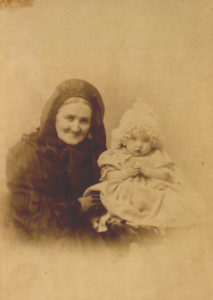
Sarah Irvine ms Gilmore with one of her grandsons probably Samuel Irvine cc1890.
In the Killyleagh 1st Presbyterian registers their children are noted as James who married Sarah Gilmore on 27 October 1840, his sister Sarah who married Hugh Ekin/Aiken on 27 December 1852 and Mary who married William McClurg on 28 December 1854. I have also searched all surrounding parishes.
Francis and Jane, including his son James and his family, were recorded as living in the townland of Tullymacnous from 1840 when the church received a stipend of £1/9/4d from both Francis Irvine & James Irvine of Tullymacnous. In the 1842-1843 pew books both Francis Irvine and James Irvine are still residing in Tullymacnous and paying 3/4d each for the year’s use of Pew 88. This continued on until the 1848-1849 collection when James is shown as living in Ballytrim townland. This townland is on the Killyleagh-Crossgar road about 2 miles from Killyleagh. The family continued to pay for pew 88 until the mid 1880s.
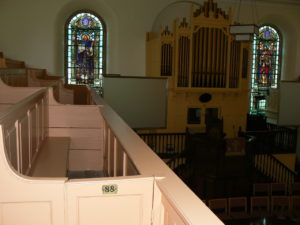
Pew 88. Killyleagh 1st Presbyterian Church. Photo by R.Edes
Townlands in Ireland are the smallest government division of land, several townlands make up each parish and several parishes make up a Diocese. Unlike the rest of the UK, Irish folk identified by their townland rather than a farm name and most residents (certainly in our extended family) leased their farm lots, some for ‘three lives’ ie three generations.
Francis and Jane’s tombstone at Killyleagh 1st Presbyterian reads ‘Erected by James Irvine of Ballytrim in memory of his father Francis Irvine who died 1st January 1853 aged 77 years. Also his mother Jane Irvine who died 7 March 1863 aged 83 years. Also his 3 sisters who died young’.[7] I first visited the church in 2002 and at that time could not find the tombstone. Many memorials that weren’t securely upright in their original spot were lined up along the church boundary walls and many more are slowly lost forever, and it seems our Irvine one is amongst them.
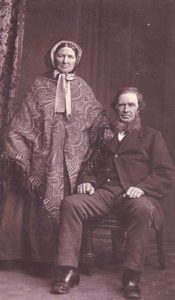
Sarah and James Irvine. Portrait by Henry G. Glen in Belfast. Taken about 1875 in Belfast.
By 1848-49 when James and Sarah moved to Ballytrim they had sons John (21 Apr 1841), Francis (23 Dec 1844) & James (19 Mar 1847). On 31 March 1849 Sarah had the first of two sets of twins, Andrew & Robert Irvine. Robert is my great-grandfather. Two years later on 13 May 1851 another set of twins was born and this time it was one of each sex, William & Margaret. This meant the couple had seven surviving children under 10 years old. Mary Anne (17 June 1853), Sarah (2 Dec 1855), Hugh (12 Apr 1857) and lastly Alexander (5 April 1859) were the remaining children born to the couple who survived. There were also three further girls who died in infancy[8]
James did not follow in his father’s footsteps as a farmer, instead choosing to be a bootmaker. From newspaper advertisements it appears that in 1868 & 1869 he supplemented his income by acting as an agent in Ballytrim for the ‘Daily Northern Whig’ and ‘Weekly Northern Whig’ newspapers.[9]
He was also a bee-keeper and won 1st Prize for 1 Skip of Honey in the Downpatrick Horticultural Society Show of Flowers, Fruit, Vegetables, budding plants etc held in Downpatrick on 25 Aug 1869.[10]
From 1865 the young Irvines began emigrating to Queensland, sometimes one by one, sometimes with siblings with some returning on visits or to stay for a year or so. I shall talk about this younger generation in future blogs. In 1888 the elderly couple, now in their 70s decided to make the journey with their sons and daughter who had remained behind to care for them. Another son, John returned to Killyleagh to escort them all on their voyage as 3rd class steerage paying passengers.
The family sailed on the steamer Iberia which left London on 14 September 1888, Plymouth 15th Sept, Gibraltar 19th Sept, Naples 23rd Sept, Port Said 27th Sept, Suez 29 Sept, Aden 3 October, Colombo 10 October, Albany 22 Oct 1888 arriving in Sydney, New South Wales on 1 Nov 1888. Onboard were Alexander, John, James, James Snr, Sarah Snr, also local names the family may have known or been related to – Mr. James Gilmore, Jamie Carruthers, Fanny Gilmore, Harrison Parkinson & F. Leitch.[11] The family then journeyed north to Brisbane on the 870-ton steamer Fitzroy, arriving here on 4 November 1888.[12]
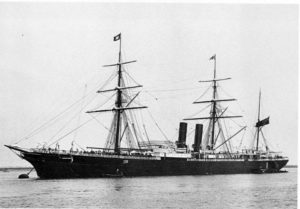
Steamer Iberia of the Orient Line.
James & Sarah settled into life with their sons William and James in James Street Fortitude Valley with James Snr passing away on 22 January 1891 and the siblings much loved mother, Sarah dying on 14 August 1896. Both are buried high on the hill in Toowong Cemetery in gravesite 13-85-7. Their daughter Sarah and sons Andrew Gilmore and Alexander Moffatt Irvine are buried with them as well as daughter in law Annie Euphemia Irvine (ms Leitch) and grandsons, David and James Campbell Irvine.[13]
Of their eight sons, two were farmers, three were bootmakers/store owners, two were store owners and one a carpenter. Since learning about these senior Irvines I have been immensely impressed by them and their dedication to the family in making that long journey in their twilight years.
[1] https://en.wikipedia.org/wiki/Killyleagh_Castle
[2] https://tinyurl.com/qso4aga
[3] https://tinyurl.com/yzwg97s7
[4] https://tinyurl.com/yfj6p5c3
[5] PRONI Ref: Killyleagh 1st Pres. MIC/637/10 (D1759/3C/1)
[6] PRONI Ref: Killyleagh 1st Pres. MIC/637/10. Part D/1759/3B/9
[7] Ulster Historical Foundation. Gravestone Inscription Series. Books 6 & 7. Killyleagh Presbyterian Church – Page 61
[8] Q’ld Death Index 1891/23846. James IRVINE aged 80 years.
[9] Newspaper article in The Northern Whig 9 also 10 Dec 1868 p1. Agent at Ballytrim, Killyleagh
[10] Newspaper article in The Belfast News-letter 25 Aug 1869 p4
[11] Source Information: Ancestry.com. New South Wales, Australia, Unassisted Immigrant Passenger Lists, 1826-1922 [database on-line]. Original data: New South Wales Government. Inward passenger lists. Series 13278, Reels 399-560, 2001-2122, 2751. State Records Authority of New South Wales.
[12] The Brisbane Courier (Q’ld. : 1864 – 1933) Monday 5 November 1888 Page 3 also The Queenslander (Brisbane, Q’ld. : 1866 – 1939) Sat. 10 November 1888. (trove.nla.gov.au)
[13] https://graves.brisbane.qld.gov.au/ Indexed as Irvine, James 1891.

Terrific post Bobbie. Pauline
Thanks Pauline. It was a good exercise to put it all down on paper after finding bits & pieces for years but not actually notating same. Bobbie Edes
A terrific and well-sourced story Bobbie.
Thanks Cathie, I did enjoy doing all that background research into the village. Bobbie
Living into their late 70’s – early 80’s seems like a pretty good achievement in the 1800’s! Thanks for sharing the story x
I so admire their courage & stamina in undertaking that long journey in a sailing vessel, we’ve certainly got determination in our genes.
Great post , Bobbie. I was particularly interested in the history of Killyleagh, as my 4x great-grandfather Edward Lowry also came from Killyleagh. Probably named Laurie from Dumfries in Scotland, who came to Ulster during the Plantation.
Thanks Russell, yes – I always keep my eye open when notating for your very early Lowry family. I’m yet to work on my 2019 PRONI notations so will sing out if I see anything. DNA has shown my Irvines were also in Dumfries (Bonshaw) as early 1300 – oh, to be able to connect the two ends!
Bobbie,thanks for that well written and very interesting post.It is so good to have all those pieces of information drawn together so beautifully. I shall put a copy into my family archives!
Thanks Lyn, and I am very grateful for the loan of the early Irvine photographs, we are indeed lucky to have ancestors who treasured their past.
Amazing research and presented brilliantly! I have kept a copy as it is a good read and possible/likely that separated by the odd generation your Irvines connect with my Margaret Irvine (b abt 1754 -d1839 Ardess Records) and husband Thomas Armstrong – parents or possibly grandparents of my 3 x great Granny Margaret Armstrong (1812 Fermanagh-1884 Dalkeith Edinburgh) and husband George Lawson of Drunhorich, Drumkeeran, Fermanagh..
Thanks for your words Joan. Your Margaret Irvine may be from those kinfolk that Christopher Irvine brought with him from Bonshaw when he settled in Fermanagh during the Plantation. These links look interesting reads on that early history
A brief account of the Irvine family, County Fermanagh
Fermanagh: Land of Lake and Legend by Breege McCusker
Well done Bobby, it could be an interesting way of bringing like minded descendants of James and Sarah together. I didn’t know James Irvine Snr kept bees, my father (James’s great grandson) also kept bees. I find it interesting how history often repeats in following generations.
Thanks Maureen, I didn’t know James Irvine Snr kept bees also, but British Newspapers via FindMyPast is a great resource. That is interesting that your father also kept bees. Chris did for a few years when we lived at Sheldon, nothing like ‘home bred’ honey.
Well done Bobbie, Your wonderful research has filled in some spaces in our Carothers Story and corrected some errors. These I will fix. Thank you for your continued support.
Thanks John, although I am envious of you having finished your family history book of your particular Irvine line.
A wonderful read, Bobby. I really enjoyed this information and photos, so carefully gathered using your amazing abilities. Congratulations.
Thanks Heather. Maybe let Kevin have a look also.
Mary Ann Irvine married my gr uncle, Wm. McClurg as you noted above in 1854. She dies 12 Feb 1858 at 37ya in the Town of Richmond, Ontario County NY, USA. They gave birth to a son James Irvine McClurg in 1856 in Town of Richmond, Ontario County NY, USA. The son James married and there are several generations from this marriage. Let me know if you want more descendants names/details. Kind regards, MacClurg (1st name) Vivian (last name)
Thanks so much for your comment MacClurg, I shall be in touch shortly via email as I’d love to hear more about your line.
I love the way our GSQ blogs bring family members together, even sometime many years later as your commenting in 2023 on a blog published in February 2020 is showing.
Hi Bobbie,
I just came across your amazing blog here. You have done some wonderful research and presented it very well. I believe we have been in touch before. We have DNA match likely though our Gilmore families. Best wishes for your future research.
Thank you Aillin, it’s great that you found my 2020 blog and remembered our previous correspondence. hanks very much for your comments about the story.
Sadly, I am no further along with confirming how my John Gilmore (b abt 1781) relates to the many Killinchy Gilmore’s my family has DNA matches with.